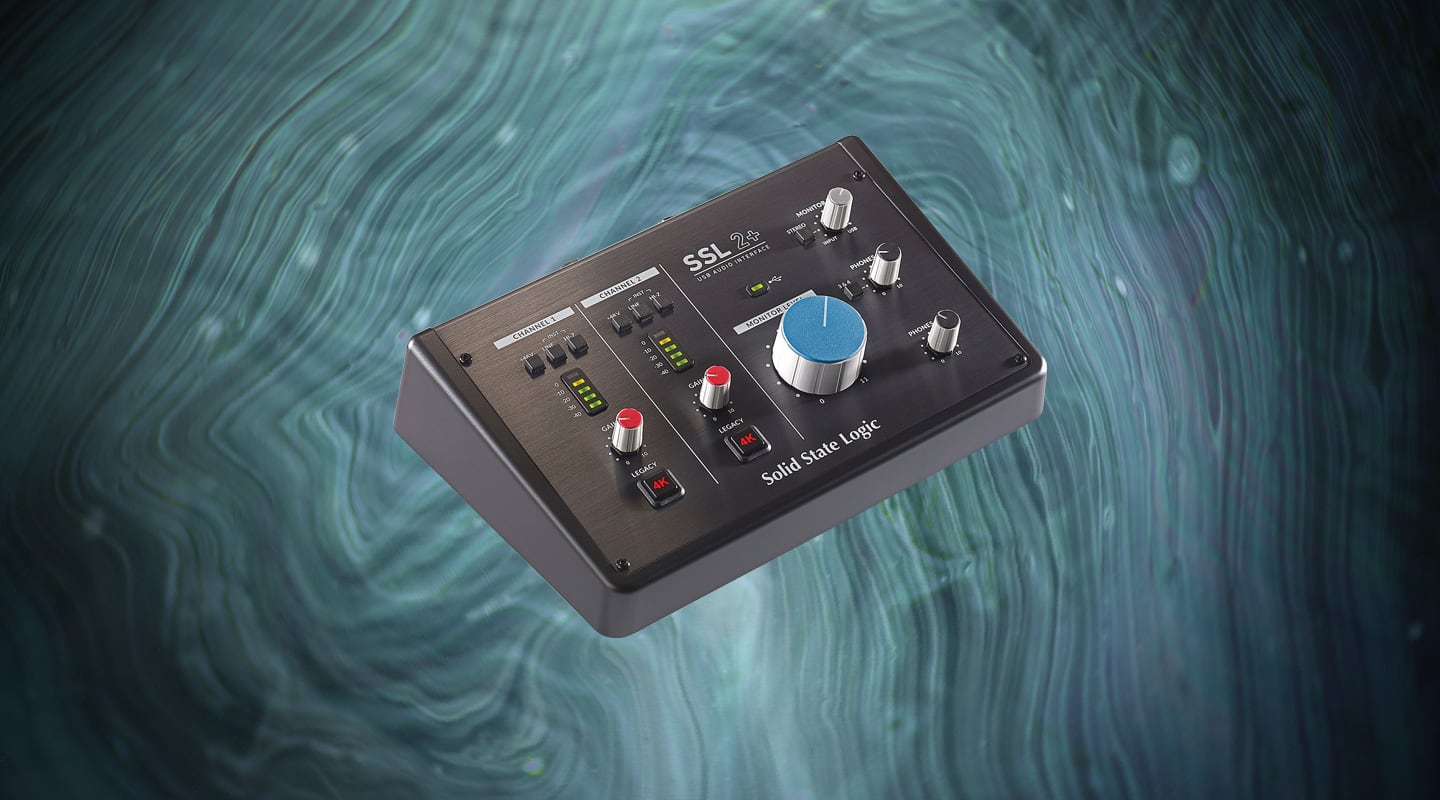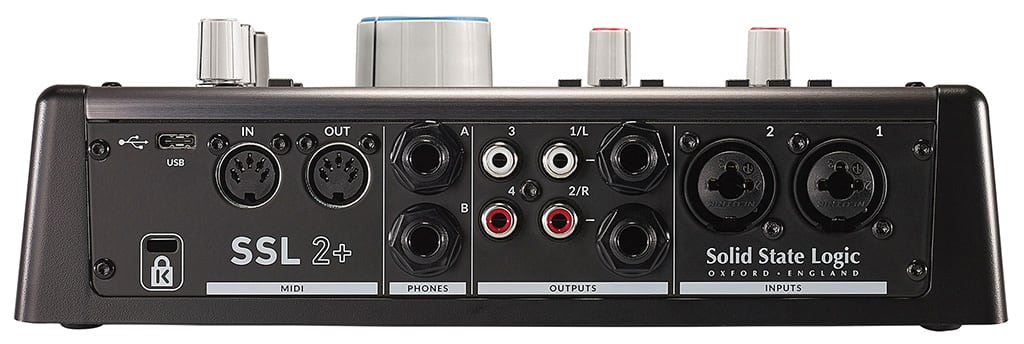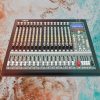
Review: SSL 2+ USB Audio Interface
The Solid State Logic name is now on a sub-A$500 interface.
The Solid State Logic brand carries a reputation which, until now, hasn’t been associated with affordability.
I remember witnessing my first SSL console as a wide-eyed nerdy audio kid and my jaw dropping when I heard how much was paid for it. A hero shot of a mammoth Duality console was my screen saver for at least six months. Heck, I revered SSL so much I was envious of my super cool friends who owned G-Series bus compressor emulation plug-ins.
Now I’m reviewing a sub-$500 USB audio interface with two inputs sporting the legendary logo. A mini Solid Stage Logic interface sitting on my desk feels quite like having a pushbike with a Ferrari badge on it.
It’s fair enough things have turned out this way – the appetite for gargantuan consoles sprawled across a swanky studio has diminished. SSL’s big-console salad days are behind it. Naturally it follows that SSL would turn its attention to the other end of the market. But everyone’s hope is it can do so without sacrificing the no-compromise reputation with it.
PLUS SIZED
The SSL 2+ is a two-input audio interface. The combi inputs cater to mic, line or instrument signals. The two onboard preamps have a 62dB gain range, a ‘Legacy 4K’ button (that we’ll talk about later), and a satisfyingly low noise level of -130.5dB. I’m grateful SSL has given each pre its own phantom power instead of an irksome ‘global’ 48V setting. That said, the lack of switchable high-pass filters and pads on the preamps, raised an eyebrow.
What makes the SSL 2+ different from its SSL 2 sibling is an extra set of stereo outputs, ie. you can create a separate mix by routing audio from your DAW to Outputs 3-4. Curiously, this bonus output manifests itself as a pair of RCA outputs, suggesting SSL assumes DJs will use Outputs 3-4 as a cueing send, perhaps. The secondary headphones port can be fed with this output too when the 3&4 button next to the Phones 2 level knob is depressed. Of course, this is handy when a tracking performer wants their own mix. The main monitor mix is fed into balanced TRS, unbalanced RCA and Phones 1 outputs. A pair of MIDI I/O rounds off the back panel.
Conversion specs on the outputs are underwhelming, with 112dB of dynamic range on the main monitor outputs and 111dB on the headphone outs. Mastering with the SSL 2+ isn’t recommended.
The interface is bus-powered via a USB-C connector with no option for an external power supply – it’s unnecessary for such a low I/O count. Physically, the unit is mostly plastic and lightweight but looks the part with that brushed metal finish. All the knobs feel great. SSL has used Alps pots all round and Neutrik connectors. A couple of the buttons were sticky on my review unit.
Class compliance means firing up the SSL 2+ is as easy as plugging it in. You don’t get routing software, although a bundle of plug-ins and other software bonuses come as standard, including SSL’s Native Vocalstrip and Drumstrip plug-ins, Native Instruments Hybrid Keys and Komplete Start, Pro Tools First and Ableton Live Lite, and 1.5GB of samples from Loopcloud.
NEED TO KNOW


DOWN TO BUSINESS
Recording a solo acoustic song with the SSL 2+ was an absolute blast – you’ve got to love the simplicity of a plug ’n’ play box without excess electronics or DSP distractions. Basic five-stage metering on each input is sufficient to set mic gain, which, by the way, is plentiful and clean. The Monitor Mix knob (takes me back to the MBox days) lets you dial in a desired balance between your DAW output and interface inputs, with a Stereo button to pan stereo sources hard left/right.
Onto the prized jewel of the 2+; the preamps. Why else would anyone buy an SSL interface if not for the promise of that classic, punchy, in-your-face character over all your recordings? SSL knows this, which is why the preamps on the 2+ feature a 4K button designed to mimic the sound of the SSL 4000 series console. A 4000 Series preamp hasn’t been copy/pasted into the 2+ but SSL states the 4K switch uses the same components to amplify the high frequencies and add subtle harmonic distortion.
In testing, the difference it makes is far from subtle. Comparing double-taked recordings with 4K on and off revealed a substantial treble boost which in turn tightens the lows and generally sizzles up the track with hints of distortion as the input level increases. Similar to the ‘Air’ switch on Focusrite interfaces, the 4K option matches certain sources better than others. For example the high end boost thinned out a shaker track too much but introduced a sophisticated-sounding sheen and aggression to male vocals. With 4K disengaged, the SSL 2+ preamps still have character and are robust, perfectly capable of being an all-round pre for the majority of acoustic sources. They have a rich and creamy sound that, in my tests, stacked very well and responded favourably to all manner of EQ and compression. I see myself using the 4K emulation as a nice fairydust sprinkle on a lifeless instrument but I fear that running all your tracks through it will sum into overly pronounced highs. Note that it acts on DI and line inputs as well.
Monitoring with the SSL 2+ has its ups and downs. The hefty knob is entirely ergonomic but I’d have liked to see at least a Mute button, or even better, Mute and Dim buttons. As it stands, going between headphones and monitors requires a big twist of the blue knob each time. Sonically, the conversion is nothing to rave about. Admittedly, comparing it with my Antelope Audio Zen Tour isn’t fair but the lack of detail and zest afforded by quality conversion is all too apparent in the SSL 2+.
PRE-REQUISITES
The best feature of the SSL 2+ are those preamps. They’re a noticeable step up from most onboard interface varieties, with the bonus of having a dash of SSL vibe from that 4K button. Otherwise, the SSL 2 and 2+ aren’t going to win any feature-driven or software freebie contest.
It will be the preamps that win the day for songwriters and producers with modest I/O requirements who are after a no-fuss, uncomplicated, bus-powered interface to lay down ideas. It also makes a great portable interface for tracking overdubs or living room vocals through the capable preamp. And perhaps most obviously, it’s aimed directly at those starting out on their recording journey who don’t want a limited budget to limit the quality of their recordings.


























what a dive from one of the world’s great brands, abuse the name, and shovel out this piece of low-end shite. Don’t be tempted by this crap